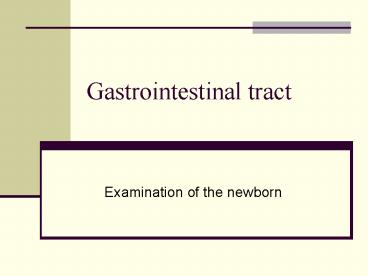Gastrointestinal tract PowerPoint PPT Presentation
1 / 24
Title: Gastrointestinal tract
1
Gastrointestinal tract
- Examination of the newborn
2
Functions of the Gastrointestinal tract
- Ingestion
- Digestion
- Absorption
- Elimination
3
Development of the gut
4
Embryology
- Week 4 Gut forms from a blind ended single tube.
From part of the yolk sac being incorporated into
the embryo during folding. The endoderm forms
the secretary lining. - Week 5 The tube is fixed at pits stomatodaeum
proctodaeum. 3 distinct parts foregut, midget and
hindgut - Foregut Oesophagus, stomach , duodenum and liver
- Midgut Jejunum, ileum ascending and transverse
gut - Hindgut Descending gut, rectum
5
Embryology
- Week 6 Rapid growth convolution and rotation.
Mid gut is too big for abdominal cavity and
herniates through the yolk sac. Endodermal
epithelium proliferates to occlude the canal. - Mouth lip closes
- Week 7 Intestinal villi
6
Fetal development
- Week 8 Recanalization complete
- Week 10 Intestines return to the abdominal canal.
The palate in the mouth fuses - Week 10 14 Swallowing present
- Week 14 -16 Bile acids produced
- Week 16 Meconium present stomach cells secreting
enzymes, acid intrinsic factor. 20 weeks gut in
final position, non nutritive sucking present - 32-34 weeks nutritive sucking
7
Assessment of the gastrointestinal tract
- History Antenatal, sibling,
- Observation skin opaque, smooth, shape- round,
symmetric, muscle tone, movement - Palpation Each quadrant should be palpated.
Liver edge can be palpated 1-2cm below costal
edge should be sharp. Abdomen depressed 1-2
cm. Spleen is not normally palpated
8
Factors to remember the baby at birth
- Stomach holds 15-30ml
- Gastric emptying time 2-3 hours
- Presence of mucus in the stomach delays emptying
further - Cardiac sphincter
- Enzymes are less effective than an adults
- HCl at birth 10 of adults
- Initiation of feeding stimulates growth of the
intestinal mucosa
9
Mouth
- Ankyloglossia inferior, short frenulum does not
cause a problem, lengthens during the postnatal
period - Epsteins pearls 80 of infants, disappear within
1 month
10
Cleft lip and palate
- 1700 Cleft lip with or without cleft palate.
70 with cleft lips have cleft palates - Teratogenic and or genetic factors
- 10 associated with other congenital
malformations - Timing of operative repair Lip 3 Months, palate
6 months. Treatment continues until child is 18
years old
11
Complications of cleft Lip and Palate
- Problems bonding
- Problems feeding
- Difficulties with hearing
- Formation of teeth
- Difficulties with speech
12
Oesophageal atresia Trachea-oesophageal fistula
- Incidence of OA 1 3 -4,000 births 85 have a
fistula - Incidence of TOF 125,000
- 50 have other congenital abnormalities cardiac,
urogenital Downs syndrome 0.9 - Associated with polyhydramnios
13
Treatment
- Excessive saliva
- Choking
- Nursed in an upright position
- Feeding withheld
- Surgical repair oesophageal anastomosis
- Prognosis Without respiratory complications 95
- Prognosis Severe respiratory complications 75
14
Umbilical hernia
- Usually close spontaneously by 2 years of age
- Not usually a cause for concern
15
Exomphalos
- Incidence 15-6, 000
- Defect through the umbilicus
- Diagnosis in the antenatal period by ultrasound
- Associated with other abnormalities such as
cardiac GU
16
Diaphragmatic Hernia
- 12000 births
- Usually left side
- Associated with polyhydramnios
- Respiratory distress
- Shift of heart sounds
- Emptiness of abdomen
17
Gastroschisis
- Defect through the abdominal wall
- Contents not covered by peritoneal sac
- Difficult surgery depends on the extent of
herniation - Associates with jejunoileal atresia
18
Atresia
- Incidence 1 15000 births, represent 1/3 of all
intestinal obstructions - Associated with Downs syndrome, oesophageal
atresia, cardiovascular disease Intrauterine
growth restriction - 30 Duodenal (110,000)
- Vomiting of bile
- Duodenal atresia Abdominal distension absent
19
Jejunoileal
- 50 of intestinal atresias
- Associated with gastroschisis
- Late intrauterine mesenteric vascular incident
- Polyhydramnios
- Bilious vomiting
- Abdominal distension
- 20-40 pass meconium
- Jaundice
20
Meconium Ileus
- 80-90 have Cystic Fibrosis
- Abdomen feels doughy
- Often has other complications such as atresias /
volvulus
21
Volvulus
- 16000
- Sudden vomiting
- Abdominal distension
22
Hirschsprungs disease
- Incidence 15000
- Absence of ganglion cells, peristalsis in
co-ordinated - Associated Downs syndome
- Delay in passing meconium, not passed by 36 hours
- Retention of gas and faeces
- Poor feeder
23
Imperforate anus
- Incidence 15,000
- More common in boys than girls
- Patency not confirmed until passage of meconium
- Passage of meconium normally occurs within 24
hours
24
Pyloric Stenosis
- 21000 births
- 5 times more common in boys
- Manifests week 2
- Projectile vomiting
- Stools become infrequent

